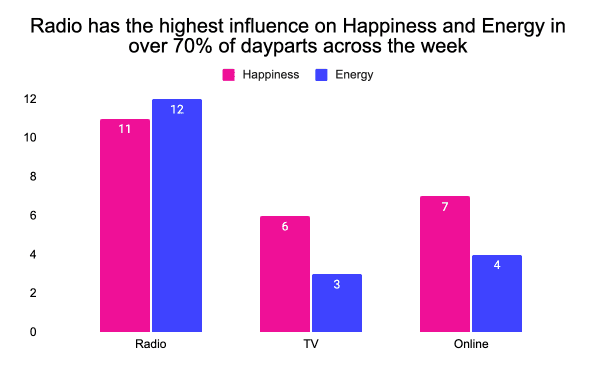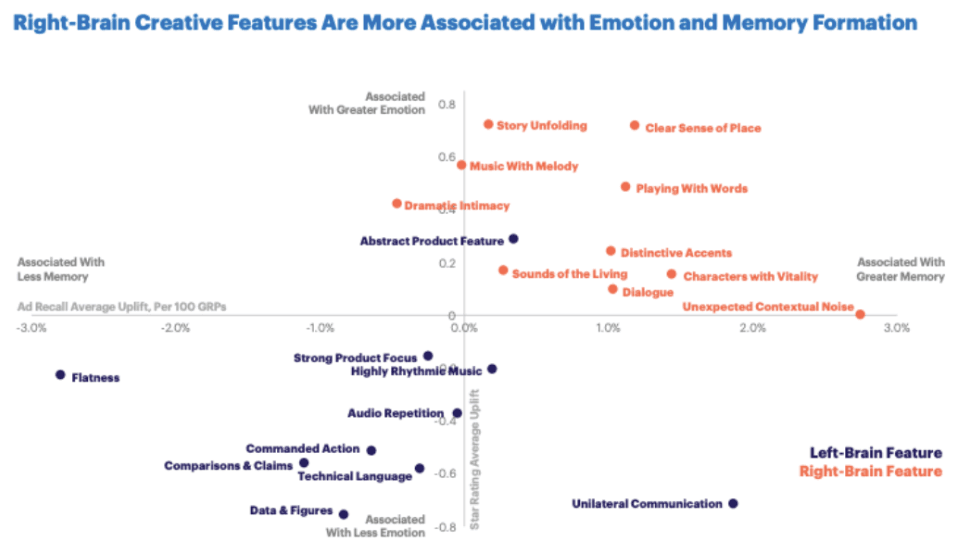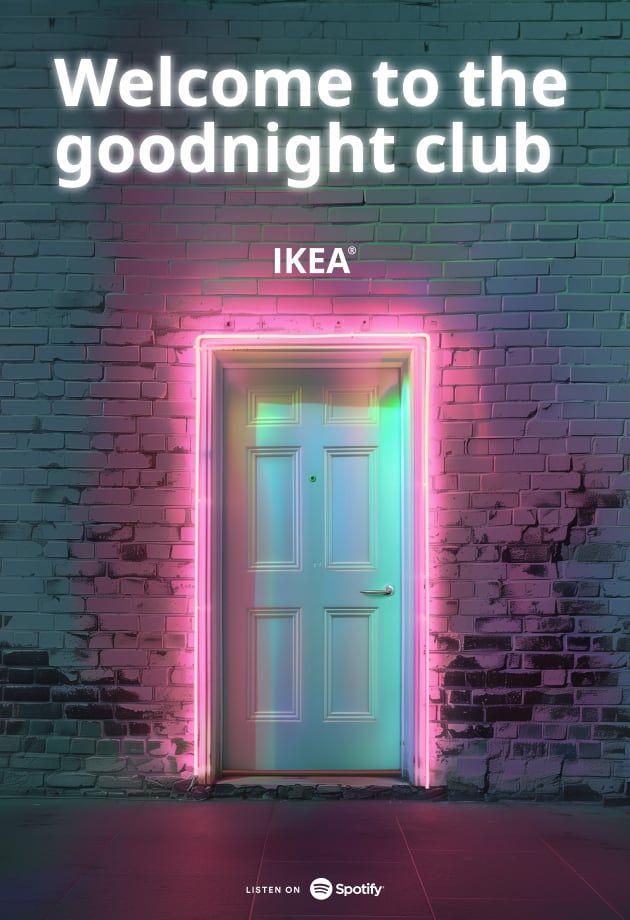
Why Audio?
Every Sound Tells a Story
08 June 2025
Since the dawn of humanity, storytelling has been central to how we connect and understand the world. Whether around campfires thousands of years ago, or in today’s podcast studios, stories have always been told aloud and brought to life by sound - the sound of a voice, a rhythm, a feeling. Sound alone can transport you, creating vivid pictures in your mind, shaped entirely by your imagination.
In today’s visually saturated world, audio offers something different: a way to cut through and connect. For brands, that makes sound a powerful creative tool and one of the most effective storytelling mediums we have.
Evoking Emotion Through Sound
There’s a wealth of research that draws on the impact of audio on our emotional states. Radiocentre’s “Radio: The Emotional Multiplier” for example, reveals that radio consumption significantly enhances listeners’ happiness and energy levels. On average, engaging with radio content doubles happiness scores and this mood elevation extends further into advertising too, with a 30% increase in positive engagement with radio ads.1

Source: Media and the mood of the nation, Radiocentre
Audio can act as an emotional catalyst, creating an environment where audiences are more tuned in to brand messages. While some ads struggle to cut through, brands who tap into the power of sound can enhance listener engagement and generate deeper emotional connections with their target audience. The commercial potential of audio is rising across channels. Globally, 41% of marketers plan to increase their podcast advertising budgets in 2025.2 Podcast ads are consistently perceived by listeners as trustworthy, relevant and useful - which is an ideal foundation for brand storytelling.
“Listen Up!” research, also from Radiocentre, looks at how brands have harnessed audio effectively to create memorable stories.3 Moonpig, the online greeting card company, has developed audio adverts that feature prominent brand elements such as their now iconic “Moonpig dot com” sonic logo, which is a recognisable brand cue. By embedding this audio identity into consistently upbeat campaigns, their message is familiar and attention grabbing. Similarly, Weetabix integrates uplifting music and playful storytelling into their radio ads, reinforcing the brand message of providing energy for the day ahead. This not only makes the ads engaging but strengthens brand recall, with the research showing they double the trust-building effects among listeners.
Audio’s Growth Across Platforms
The shift in how we consume audio is shaping its storytelling potential. In 2024, commercial radio listening via online platforms accounted for 31.1% of all listening. Smart speaker usage alone now accounts for 17.6% of all radio listening. This evolution shows how audio content is increasingly woven into our daily digital lives, making it easier for stories told through sound to reach people wherever they are. For example, Spotify has experienced significant growth; as of Q1 2025, Spotify's global monthly active users reached 678 million. The platform's ad-supported monthly active users totaled 423 million, and Spotify's ad-supported revenue remained steady, driven by a boost in impressions sold across both music and podcasts.
Total radio advertising revenue reached £745.8 million in 2024, growing 4.2% year on year, highlighting advertisers’ confidence in audio’s power to perform and create lasting impressions through compelling stories told through sound.4 Podcasts have seen rapid growth, both in audience numbers and in advertising investment. The Global podcast advertising market grew by 16% year on year in 2024, surpassing $4 billion.5 These figures underscore the growing confidence among advertisers in the effectiveness of audio to hold attention and deliver storytelling that resonates.
Deep Emotional Response
Effective storytelling in advertising isn’t just about getting noticed, it’s about creating emotional connections that last. This is where audio excels.
“Listen Up!” found that audio ads which feature right-brain creative elements i.e. music, humour, narrative and characters, are more likely to be memorable and emotionally engaging. It’s not just about how they make us feel though, these kinds of ads are shown to drive real results, including an 8.2% uplift in consumer actions like purchase and brand usage (Radiocentre & System1).3 Storytelling increases ad effectiveness, so using a storytelling medium such as audio, will help your brand to deliver tangible results.
This isn’t new thinking, it echoes findings from System1’s Lemon report, which showed that ads which trigger emotional, right-brain responses are more effective long-term. Storytelling is the key; it’s the thread that keeps audiences engaged, builds trust and makes brands more memorable.

Source: System 1 and Radiocentre
Award Winning Audio: Specsavers
Last year, Specsavers continued to use audio advertising to reinforce their brand message and launched “The Misheard Version” campaign that addressed common misinterpretations of everyday phrases, highlighting the importance of clear hearing. The campaign won the UK’s first Cannes Lions Grand Prix for Audio & Radio with humour and music playing a crucial role in the campaign's success.
To promote its audiology services, Specsavers teamed up with Rick Astley to launch a re-recording of his 1980s song ‘Never Gonna Give You Up’ with some of the lyrics changed to reflect how people misheard the original. The song was played over 20 million times in the first eight hours of the campaign, driving a 138% increase in hearing loss searches and making hearing the UK’s number one trending topic. The use of music and humour here, enhanced the storytelling by making it more engaging and memorable.6
Sound-First Storytelling: IKEA’s Sleep Easy with Spotify
Working with Spotify as a preferred partner, we helped to bring IKEA’s Sleep Easy Stage campaign to life across the US.

Designed to guide users toward better rest, the experience sent listeners on a personalised journey to find their ideal Sleep Soundscape, complete with ambient audio, a custom soundboard, and tailored playlists. The activation also highlighted IKEA’s six Sleep Essentials, blending branded storytelling with interactive audio.
The results speak for themselves, 94.6% of users who opened the experience went on to interact, with a third completing the journey, demonstrating how well the content resonated. It’s proof that when storytelling meets sound, audiences don’t just listen, they actively engage too.
Sound That Stays With You
Consumers are inundated with visual stimuli, and so audio as a medium offers a space to be heard, and to feel. Its unique ability to evoke emotion and foster personal connections makes it the ultimate storytelling tool. Brands can embrace this by creating compelling narratives for their advertising campaigns, which resonate with audiences on an emotional level to ensure their messages are not just heard, but also felt.
Audio is also emerging as a preferred medium for younger audiences. A 2024 survey by the National Literacy Trust found that 42.3% of children aged 8-18 now prefer listening to audio content in their free time, compared to 34.6% who say they enjoy reading for pleasure.7 From audiobooks to narrative led podcasts, sound is also helping to shape a new generation of listeners, building emotional literacy and sparking imagination and habits that will carry on into adulthood.
In every generation and every format, sound continues to prove that it’s the most powerful way to tell a story. Because when stories are told through sound, they don’t just reach our ears - they stay with us.
Sources
1Radiocentre - Radio: The Emotional Multiplier
2Kantar
3Radiocentre and System 1 - Listen Up!
4Radiocentre sourced from AA/WARC
5The marketing blog
6Contagious, Cannes Lions 2024 Winners
7The Guardian
Fancy a chat? Email us and one of the team will be in touch to discuss how we can create some audio advertising, tailored to your needs.